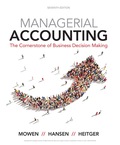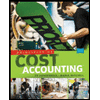
Concept explainers

(Appendix 4B) Sequential Method of Support Department Cost Allocation
Refer to Exercise 4-51 for data. Now assume that Stevenson uses the sequential method to allocate support department costs to the operating divisions. General Factory is allocated first in the sequential method for the company.
Required:
- 1. Calculate the allocation ratios for Power and General Factory. (Note: Carry these calculations out to four decimal places.)
- 2. Allocate the support service costs to the operating divisions. (Note: Round all amounts to the nearest dollar.)
- 3. Assume divisional
overhead rates are based on direct labor hours. Calculate the overhead rate for the Battery Division and for the Small Motors Division. (Note: Round overhead rates to the nearest cent.)
1.
Computeallocation ratios for power and general factory under the sequential method.
Explanation of Solution
Sequential Method:
Sequential method recognizes that there is possible interaction between the support departments. However, it does notaccount for such interaction in full which makes it more accurate as compared to the direct method.
Use the following formula to calculate allocation ratios for general factory on the basis of number of square footage:
Power:
Power=Number of squarefootage in powerTotal squarefootage
Substitute 1,000 for number of square footage in power and 21,000 for total square footage in the above formula.
Power=1,000 squarefootage21,000 squarefootage=0.0476
Therefore, the cost assignment ratio for S2 is 0.0476.
Battery:
Battery=Number of squarefootage in batteryTotal squarefootage
Substitute 5,000 for number ofsquare footage in battery and 21,000 for total square footage in the above formula.
Battery=5,000 squarefootage21,000 squarefootage=0.2381
Therefore, the cost assignment ratio for battery is 0.2381.
Small motors:
Smallmotors=Number of squarefootage in smallmotorsTotal squarefootage
Substitute 15,000 for number ofsquare footage in small motors and 21,000 for total square footage in the above formula.
Smallmotors=15,000 squarefootage21,000 squarefootage=0.7143
Therefore, the cost assignment ratio for painting department is 0.7143.
Use the following formula to calculate cost assignment ratios for power on the basis of number of machine hours:
Battery:
Battery=Number of machinehours of batteryTotal machinehours of operating departments
Substitute 7,000 for number of machine hoursofbattery and 8,000 for total machine hours ofoperating department in the above formula.
Battery= 7,000 hours8,000 hours=0.8750
Therefore, the assignment ratio for assembly department is 0.8750.
Small motors:
Smallmotors=Number of machinehours of smallmotorsTotal machinehours of operating departments
Substitute 1,000 for number of machine hours of painting and 8,000 for total machine hours of operating department in the above formula.
Painting=1,000 hours8,000 hours=0.1250
Therefore, the assignment ratio for painting department is 0.1250.
2.
Apportion the support service costs to the operating divisions by using the sequential method:
Explanation of Solution
Allocation:
Allocation can be defined as the process of assigning the indirect costs to the cost object with the help of a convenient and reasonable method. It is essential to allocate indirect costs to the cost objects.
| Support departments | Operating departments | |||
| Power($) | General factory($) | Battery($) | Small motors($) | |
| Direct costs | 160,000 | 430,000 | 163,000 | 84,600 |
| Allocate: | ||||
| Power | 20,468 | (430,000) | 102,383 | 307,149 |
| General factory | (180,468) | 157,910 | 22,559 | |
| Total | 0 | 0 | 423,293 | 414,308 |
Table (1)
Working Note:
#. Allocation of support service costs to power:
Allocation cost=General factory cost×Power ratio of general factory=$430,000×0.0476=$20,468
1. Allocation of support servicecost to battery:
For power cost:
Allocation cost=Power cost×Battery ratio of power=$430,000×0.2381=$102,283
For general factory cost:
Allocation cost=Generalfactory cost× Battery ratio of generalfactory=$180,468×0.8750=$157,910
2. Allocation of support service cost to small motors:
For power cost:
Allocation cost=Power cost×Smallmotors ratio of power=$430,000×0.7143=$307,149
For general factory cost:
Allocation cost=Generalfactory cost× Generalfactory ratio of generalfactory=$180,468×0.1250=$22,559
3.
Compute overhead rate of battery and small motors divisions.
Answer to Problem 52E
The overhead rate of battery and small motors divisions is $23.52 and $6.91 respectively.
Explanation of Solution
Overhead Rate:
The amount which is calculate at the beginning of the accounting year for a related activity by dividing the total estimated annual overhead by estimated annual activity level is known as the overhead rate.
Use the following formula to calculate overhead rate for battery division:
Overhead rate=Estimated annual overheadEstimated annual activity level
Substitute $423,293 for estimated annual overhead and 18,000 DLH for estimated annual activity level in the above formula.
Overhead rate=$423,29318,000 DLH=$23.52
Therefore, overhead rate is $23.52.
Use the following formula to calculate overhead rate for small motors division:
Overhead rate=Estimated annual overheadEstimated annual activity level
Substitute $414,308 for estimated annual overhead and 60,000 DLH for estimated annual activity level in the above formula.
Overhead rate=$414,30860,000 DLH=$6.91
Therefore, overhead rate is $6.91.
Want to see more full solutions like this?
Chapter 4 Solutions
EBK MANAGERIAL ACCOUNTING: THE CORNERST
- On January 1 of the current year, Piper Company issues a 4-year, non-interest-bearing note with a face value of $8,000 and receives $4,952 in exchange. The recording of the issuance of the note includes a: a. credit to Notes Payable for $4,952. b. credit to Discount on Notes Payable for $3,048. c. debit to Discount on Notes Payable for $3,048. d. debit to Cash for $8,000.arrow_forwardPLease helparrow_forwardPLEASE HELParrow_forward
- Hy expert provide answer with calculationarrow_forwardDuring September, the assembly department completed 10,500 units of a product that had a standard materials cost of 3.0 square feet per unit at $2.40 per square foot. The actual materials purchased consisted of 22,000 square feet at $2.60 per square foot, for a total cost of $57,200. The actual material used during this period was 25,500 square feet. Compute the materials price variance and materials usage variance.arrow_forwardBluesy Electronics recorded the following financial data: Net Sales $720,500 Average Inventory at Cost = $80,200 Gross Margin Percentage = 42% Calculate the GMROI.arrow_forward
- Need help this question solutionarrow_forwardXYZ Company has a gross profit margin of 0.30, an operating profit margin of 18%, a total asset turnover ratio of 2.0x, and cost of goods sold of $700,000. The company's tax rate is 35%, and it has no debt. Calculate XYZ Company's Return on Assets (ROA).arrow_forwardMON Pools builds custom swimming pools. MON budgets that they will build 16 pools during the month of June at a price of $22,750 per pool. The actual pools built by MON during June were 13 pools at a price of $23,420 per pool. What is the Flexible Budget Variance for June?arrow_forward
 Cornerstones of Cost Management (Cornerstones Ser...AccountingISBN:9781305970663Author:Don R. Hansen, Maryanne M. MowenPublisher:Cengage Learning
Cornerstones of Cost Management (Cornerstones Ser...AccountingISBN:9781305970663Author:Don R. Hansen, Maryanne M. MowenPublisher:Cengage Learning Managerial Accounting: The Cornerstone of Busines...AccountingISBN:9781337115773Author:Maryanne M. Mowen, Don R. Hansen, Dan L. HeitgerPublisher:Cengage Learning
Managerial Accounting: The Cornerstone of Busines...AccountingISBN:9781337115773Author:Maryanne M. Mowen, Don R. Hansen, Dan L. HeitgerPublisher:Cengage Learning Principles of Cost AccountingAccountingISBN:9781305087408Author:Edward J. Vanderbeck, Maria R. MitchellPublisher:Cengage Learning
Principles of Cost AccountingAccountingISBN:9781305087408Author:Edward J. Vanderbeck, Maria R. MitchellPublisher:Cengage Learning Managerial AccountingAccountingISBN:9781337912020Author:Carl Warren, Ph.d. Cma William B. TaylerPublisher:South-Western College Pub
Managerial AccountingAccountingISBN:9781337912020Author:Carl Warren, Ph.d. Cma William B. TaylerPublisher:South-Western College Pub



